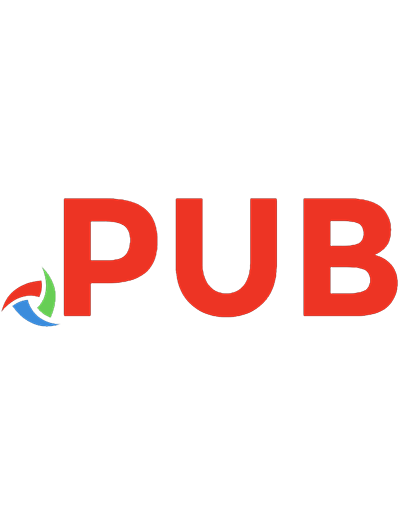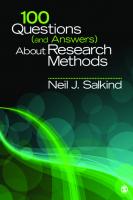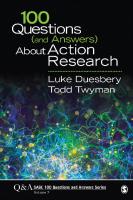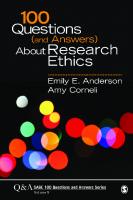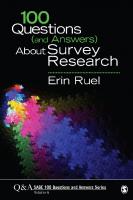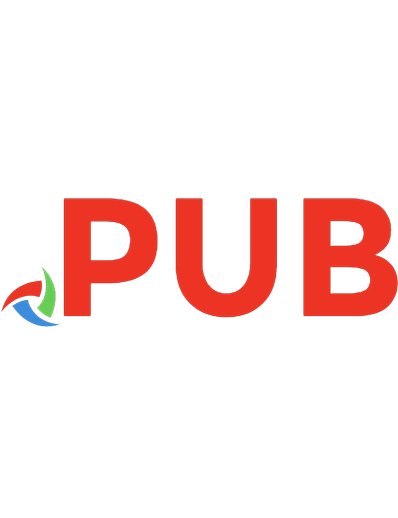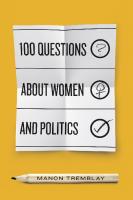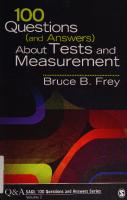100 Questions (and Answers) About Tests and Measurement 9781412992039, 9781452283388, 9781452283395
112 36 9MB
English Pages [220] Year 2015
Polecaj historie
Citation preview
100
Questions
(and Answers)
About
|ests
and
vieasurement
hi HK!
SAGE 100 Questions and Answers Seles” Volume 2
6
Hundreds
questions 100 .
Questions (and Answers)
About Research Methods
|
more cnaeruul 100 .
Questions (and Answers)
About Statistics Neil J. Salkind
O&: A100 Geesens andAnswers Series
100 Questions (and Answers) About Research Methods
)
100 Questions (and Answers) About Statistics
Neil J. Salkind
Neil J. Salkind
ISBN: 978-1-4129-9203-9
ISBN: 978-1-4522-8338-8
Visit sagepub.com/100qa for a complete series listing!
100 Questions (and Answers) About Tests and Measurement
set ii eat
O&
SAGE 100 Questions and Answers Series
Neil J. Salkind, Series Editor 1.
100 Questions (and Answers) About Research Methods, by Neil J. Salkind
2.
100 Questions (and Answers) About Bruce B. Frey
3.
Tests and Measurement,
100 Questions (and Answers) About Statistics, by Neil J. Salkind
Visit sagepub.com/100qa for a current listing of titles in this series.
by
100 Questions (and Answers) About Tests and Measurement
Bruce Barrey, The University of Kansas
@SAGE Los Angeles |London |New Delhi Singapore |Washington DC
@SAGE Los Angeles |London |New Delhi Singapore |Washington DC
FOR INFORMATION:
Copyright © 2015 by SAGE Publications, Inc.
SAGE Publications, Inc.
All rights reserved. No part of this book may be reproduced or utilized in any form or by any means, electronic or mechanical, including photocopying, recording, or by any information storage and retrieval system, without permission in writing from the publisher.
2455 Teller Road Thousand Oaks, California 91320
E-mail: [email protected] SAGE Publications Ltd. 1 Oliver's Yard
55 City Road London EC1Y 1SP United Kingdom
Printed in the United States of America
SAGE Publications India Pvt. Ltd.
ISBN: 978-1-4522-8339-5
B 1/1 1 Mohan Cooperative Industrial Area Mathura Road, New Delhi 110 044
Library of Congress Control Number: 2014933224
India
SAGE Publications Asia-Pacific Pte. Ltd.
3 Church Street #10-04 Samsung Hub Singapore 049483
This book is printed on acid-free paper. Acquisitions Editor;
Assistant Editor:
Vicki Knight
Katie Guarino
Editorial Assistant:
Yvonne McDuffee
Production Editor:
Jane Haenel
Copy Editor:
/
Certified Chain of Custody
Lana Todorovic-Arndt =
Typesetter:
C&M Digitals (P) Ltd.
Proofreader: Indexer:
SERN:
Promoting Sustainable Forestry
INITIATIVE
Www.sfiprogram.org SFI-01268
SFI label applies to text stock
Scott Oney
Michael Ferreira
Cover Designer:
Candice Harman
Marketing Manager:
Nicole Elliott
14 15 16 17 1810987654321
Contents
Preface
x
Acknowledgments
_ xii
About the Author
xiii
PART 1: THE BASICS
1
1. So, What Is 100 Questions (and Answers) About Tests and Measurement About?
What Exactly Is a Test?
g
3
3. What Exactly Is Measurement?
Most of the Ways I Can Think of to Measure Something Seem Pretty Straightforward. What Are the Important Differences Between Measuring Something Like Weight and Something More Abstract Like Knowledge? 5. What Are Some of the Different Types of Tests, and How Are They Used?
PART
6 8
What Are the Different Ways to Interpret a Test Score?
10
What Are the Different Ways to Judge Whether a Test Is Any Good?
i
2: UNDERSTANDING
VALIDITY
15
8. What Does It Mean to Say That a Test Is Valid?
16
9. What Is Content Validity, Why Is It Important, and How Is It Established?
18
10.
What Is Criterion Validity, Why Is It Important, and How Is It Established?
19
What Is Construct Validity, Why Is It Important, and How Is It Established?
20
What Is Consequential Validity, Why Is It Important, and How Is It Established?
Ze
13.
What Does It Mean to Say a Test Is Biased?
22
14.
What Does Evidence of Test Bias Look Like?
23
11. 12.
15.
Some Types of for Some Types of Tests. What’s for the Validity
Validity Evidence Must Be More Important of Tests, but Not Important for Other Types the General Strategy for Making an Argument of a Test?
16. I Need to Build a Test. How Can I Make Sure It Is Valid? PART 3: UNDERSTANDING
24
26 29
RELIABILITY
We
What Is Reliability, and How Is It Different From Validity?
30
18.
What Are the Different Types of Reliability?
32
IG,
If the Traditional Way of Thinking About Reliability Is Called the Classical Theory, That Suggests There Is a More Contemporary Way of Thinking About Things. What Has Come Since?
34
What Are the Important Differences Between Classical and Item Response Theory
36
21.
What Does Internal Reliability Look Like?
a
22n
What Does Test-Retest Reliability Look Like?
59
22)
What Does Inter-rater Reliability Look Like?
41
24.
Other Than the Three Main Types of Reliability, Are There Others?
43
How Are Reliability and Validity Related to Each Other?
45
20)
29).
20. Some Types of Reliability Evidence Must Be More Important
2:
for Some Types of Tests, but Not Important for Other Types of Tests. What's the General Strategy for Making an Argument for the Reliability of a Test?
47
I Need to Build a Test. How Can I Make Sure It Is Reliable?
49
PART 4: THE STATISTICS
OF MEASUREMENT
51
28.
When Establishing Validity or Reliability, 1 Can Understand That Examining Whether Two Sets of Scores Are Related Is Important, but How Do I Do That?
29.
How
Can I Calculate
D2
a Number to See Whether a
Test Has Content Validity?
54
30.
For Reliability’s Sake, I Can See That Showing a Test Is Consistent Within Itself Is Important, but How Do I Do That?
55
Oli
How Can I Improve the Accuracy of the Split-Half Reliability Coefficient?
ay
od,
I Never See Split-Half Reliability Reported. Is There Way to Show That a Test Has Internal Consistency?
33:
We've Got Two Ways to Establish Internal Reliability. Which Way Is Best?
a More Common
a2 61
34. How Can I Use Reliability Coefficients to Improve My Validity Estimates?
“Pe What Useful Information Can I Get by Analyzing Individual Items on a Test?
63 65
30. How Do I Calculate and Interpret the Difficulty of a Test Question?
67
ete
What Is Item Discrimination, and How Do I Calculate It?
69
38.
What Is the Relationship Between Item Difficulty and Item Discrimination?
71
PART 5: ACHIEVEMENT TESTS
73
39.
What Are Achievement Tests, and How Are They Used?
74
40.
How Is the Validity of an Achievement Test Established?
Vhs)
41.
How Is the Reliability of an Achievement Test Established?
ah
42.
What Does SAT Stand for, and What’s the Test All About?
79
43.
That Other Big College Admissions Test, the ACT: What Is It, and How Does It Differ From the SAT?
81
For Admission to Graduate School, My College Requires the GRE Test. What Is It, and Why Is It Better Than the SAT or ACT for Graduate School?
83
44.
45: What Are the Major Tests for Professional Schools, and What Are They Like?
85
40.
How Do I Score High on an Achievement Test?
87
47.
How Do Test Preparation Courses Work?
89
PART 6: INTELLIGENCE TESTS
91
48.
What Are Some of the Commonly Used Intelligence Tests?
92
49.
What Is an IQ?
94
50.
How Is Intelligence Usually Defined and Measured?
95
a1.
How Is the Validity of an Intelligence Test Established?
96
How Is the Reliability of an Intelligence Test Established?
97
What Is the Wechsler Intelligence Test?
98
What Is the Woodcock-Johnson Intelligence Test?
100
What Is the Kaufman-ABC Intelligence Test?
102
What Is the Stanford-Binet Intelligence Test?
104
What Are Some Alternatives to the
Traditional Intelligence Tests?
106
Why Are Intelligence Tests Controversial?
108
PART 7: PERSONALITY TESTS AND ATTITUDE
2,
SCALES
What Do Personality Tests Measure?
109 110
60. How Is the Validity of a Personality Test Established?
112
61. How Is the Reliability of a Personality Test Established?
114
62. What Are the Different Ways to Measure Attitude?
115
63. How Do I Construct My Own Likert-Type Attitude Scale?
Cy
64. How Do I Construct My Own Thurstone Attitude Scale?
119
65. How Are Mental Disorders Diagnosed?
20
66. What Is the MMPI Personality Test?
123
67. How Is Depression Measured?
125
68. How Are Alcoholism and Other Addictions Diagnosed?
126
PART 8: CLASSROOM
ASSESSMENT
69. How Do I Decide What to Assess in My Classroom? 70. wat
What Are the Different Types of Assessment I Can Use?
129 130 132
How Are the Validity and Reliability of Classroom Assessments Established?
134
72.
What Are the Types of Traditional Paper-and-Pencil Test Items?
136
1
What Are the Characteristics of a
Good Multiple-Choice Question?
138
74.
What Are the Characteristics of a Good Matching Question?
140
7:
What Are the Characteristics of a
Good Fill-In-the-Blank Question?
141
76. What Are the Characteristics of a Good True-False Question?
143
pi.
Can I Improve the Quality of a Test After I Give It?
144
78.
I Want to Measure My Students’ Skills and Ability. How Do I Design a Good Performance-Based Assessment?
146
I'd Like to Use Portfolio Assessment in My Classroom. What Are the Guidelines for Doing That Well?
148
80.
How Can Classroom Assessments Actually Increase Learning?
150
feyll.
I Want My Tests to Be Authentic. What Does That Mean, and How Do I Accomplish That Goal?
151
I Want My Tests to Be Valid for All of My Students. What Are the Universal Design Principles I Need to Follow?
Ss)
WE
82.
PART 9: UNDERSTANDING
TEST REPORTS
155
83.
What Is the Normal Curve?
156
84.
I See Percentile Ranks Reported All the Time. What Are Those?
158
85.
What Does It Mean to Say That a Test Is Standardized?
86. What Is a Standardized Score, and Why Is It Important?
9 161
87.
What Is a Z-score?
88.
What Is a T-score?
163 165
89.
I Want to Understand How I Did on the SAT. How Can I Interpret My Score?
167
90.
How Can I Interpret My ACT Score?
169
9S)
I Took the GRE. What Does My Score Mean?
171
92. What Is a Standard Error of Measurement?
1/3
ye
175
PART
What Is a Confidence Interval?
177
10: SURVEYS
94. What Is a Survey, and How Does It Work? 95.
I Need to Build My Own Survey. What Are the Characteristics of Good Survey Questions?
96. How Do I Put Together a Generalizable Sample?
178
179 181
oT. I’ve Got My Survey and a Sample. Now, How Do I 98.
Administer the Survey?
183
How Do I Report the Results of My Survey?
185
o9: What Is the “Margin of Error” That Is Often Reported 187
With Survey Results? 100. Index
What Are Common
Mistakes Made in Survey Construction?
189 191
Preface
e are surrounded by scores. To a large extent in the modern world, we are defined by test performance. For students and teachers, a typical day at school focuses on assessments or preparing for assessment. College students’ course work increasingly includes training in measurement,
testing, and assess-
ment. Research, especially in the social sciences, depends on valid and reliable measurement to test hypotheses and, as it turns out, to even have a chance at getting statistically significant results. 100 Questions (and Answers) About Tests and Measurement asks (and answers) important questions about the world of social science measurement. It is meant to be an introduction to students new to the concepts, advanced students, and professionals who could use a review of measurement ideas and procedures, and to anyone interested in knowing more about a test they have to take and interpreting the score they will receive. The questions (and answers) are all numbered and placed in an order that we think makes sense, but you should be able to read any question (and answer) from anywhere in the book and not have to have read anything that came before it. If you are interested in getting more information, though, each answer ends with suggestions for other questions that deal with related topics. The 100 questions (and answers) are organized into 10 categories so you can find the answer you need quickly and maybe accidentally learn other related stuff while you're at it. The 10 sections are e The Basics e Understanding Validity e Understanding Reliability e e e
The Statistics of Measurement Achievement Tests Intelligence Tests
e Personality Tests and Attitude Scales e
Classroom Assessment
e
Understanding Test Reports
e
Surveys
You'll notice that the book is small and all the questions (and answers) are just a page or two. This is by design so that 100 Questions (and Answers) About Tests and Measurement can act as a handy, concise reference tool to keep close at hand for whenever measurement problems or concerns rear their thorny heads.
Preface
pP
xi
The goal was to provide brief answers that present the most important concepts, procedures, and information. There are likely hundreds more questions that we could have included, but we hope you'll find your most urgent questions asked (and answered) here!
Acknowledgments
T hanks to the editing and production team at SAGE, headed by Vicki Knight, Senior Editor, and Neil Salkind, Series Editor. It has been a pleasant experience thanks to you and your associates. You’ve all been very nice to me. Thank you to all of the reviewers for their time and input: Héctor B. CrespoBujosa, Carlos Albizu University, San Juan, Puerto Rico; Bruce R. DeForge, University
of Maryland Baltimore; Cherisse Y. Flanagan, Abilene Christian University; Jessica C. Hauser, St. Vincent College; Natalie Johnson-Leslie, Arkansas State University; David Oliver Kasdan, Oakland University; William C. Kuba, William Penn University; Karen S. Linstrum, Northwestern Oklahoma State University; Michael J.
Ray, The College at Brockport; and Stephanie L. Scifres, Indiana University Purdue University at Columbus. An additional expression of gratitude goes to members of the production team.
xii
»
5
4. Ratio. This level of measurement is interval scaling without any negative numbers allowed. With a thermometer, which is at the interval level, scores below
0 are allowed. The 0 is arbitrary, though, and does not represent the complete absence of something. At the ratio level, though, there is a true 0. Nothing is below it. The simple counting of objects is measurement at the ratio level. Your aunt might have zero cats, but she cannot have less than zero cats. It is named “ratio”
level, by the way, because the use of ratios and proportions now makes sense. Your aunt can have twice as many cats as her neighbor, but we don’t often talk about it being half as cold today as yesterday. More questions? See #2 and #62.
QUESTION #4 Most of the Ways I Can Think of to Measure Something Seem Pretty Straightforward. What Are the Important Differences Between Measuring Something Like Weight and Something More Abstract Like Knowledge? Mes: in education and psychology differs from measurement in the physical sciences like physics and engineering in one important way. The object of measurement, the thing for which you wish to assign a score representing quantity, is abstract and can’t be seen. It might not even exist! These invisible traits and human characteristics that we social scientists wish to measure are called constructs.
A construct (pronounced CON-struct) is not directly observable. It is a conceptual, intangible variable that a test maker has built and defined (thus, the term
construct) intellectually through the application of theory and research. The job of the test developer is to find ways to make these unseen constructs observable. Typical strategies for assessing constructs are e
Asking questions
This is the most traditional way of finding out what’s going on inside our heads. e
Observing behaviors
We can’t see thoughts, but we can see behavior. e
Assigning performance tasks
Evaluators from classroom teachers to work supervisors make judgments about our skills, abilities, and personality traits by looking at the work we produce.
PART 1: THE BASICS
p>
7
Because we cannot see constructs, the quality of social science measurement depends to a large extent on how well the scores on a test really reflect the construct of interest. These issues of validity are discussed in Questions #7 and #8. Some of the constructs that are common measurement goals and are discussed in this book include knowledge, ability, skill, intelligence, potential college success, personality, attitude, depression, and alcoholism. See how these are different variables, in terms of measurement, than height, weight, speed, or thick-
ness? The art of measurement in the social sciences is the opposite of the stage magician’s art. Instead of making things disappear, test makers make things appear. More questions? See #8 and #17.
QUESTION #5
What Are Some of the Different Types of Tests, and How Are They Used? 7 Ps tests covered in this book are all designed to assign a score to humans. The scores are meant to quantify levels of invisible traits called constructs. All the constructs associated with the tests we are interested in are within the minds of people and can’t be seen directly. They are reflections of how we feel, what we can do, and what we know. These are the tests of education and psychology. There are three major types of educational and psychological measures. They differ in their intended purposes, why we use them, and the nature of the constructs they measure. Most tests in the world of education can be classified as achievement tests. These are the tests that measure knowledge and understanding of the information and skills we learn in school. The format of achievement tests varies from the short and informal, like when a teacher calls on a student to answer a question, to the
somewhat important, such as that big midterm chemistry exam, to the high-stakes intensity of a 3-hour, standardized college admissions test. Major achievement tests include the SAT, the ACT, and the Graduate Record Exam (GRE). Another use of testing is to measure ability in order to predict or estimate how well one will perform in school or on the job. The general category name for tests that predict the future is aptitude tests. By far the most common type of aptitude test in both education and psychology is the intelligence test. Intelligence tests are meant to assess those abilities that correlate with success in school, on the job,
and while living independently in the world. Major intelligence tests include the Wechsler Intelligence Scale for Children (WISC), the Woodcock-Johnson Tests of Cognitive Abilities, the Kaufman Assessment Battery for Children (K-ABC), and the Stanford-Binet Intelligence Scale. A third type of test in the world of psychology and, sometimes, in education, is broadly labeled as a personality test. These measures are designed to score our feelings, our attitudes, and how our minds work. Sometimes the constructs are well-defined complex mental illnesses. Other times, personality tests have less complicated lower-stakes goals, such as measuring how you feel about a company’s new
line of baked
beans.
Major
tests
in this category,
such
as the Minnesota
Multiphasic Personality Inventory (MMPI), assess personality types and disorders or are used to diagnose problems, like depression or addiction to alcohol and other drugs.
PART 1: THE BASICS
p
9
Other questions and answers in this book explore the characteristics of these tests that are necessary for them to be useful and examine how the scores from these measures are used and interpreted. These methods of test development and application are essentially the same for all educational and psychological tests, whether they are meant to measure achievement, assess intelligence and aptitude, or identify personality and attitude.
More questions? See #4 and #7.
QUESTION#6 What Are the Different Ways to Interpret a Test Score?
| Dee are really only two ways that a score on a test can mean anything: 1. The score can be interpreted by comparing it to the scores of others. Is it higher, lower, or about average compared with other folks who took the same test? And how much higher or lower compared with others is it? This approach, which gives meaning to a score by understanding what sort of scores normal people Gf you'll excuse the expression) get, is called norm-referenced. What is important in this approach is whether a score is above or below average. 2. The score can be interpreted by understanding what the score directly represents in terms of the level of some trait, which chunk of knowledge has been learned, how well a skill has been mastered, the presence or absence of some condition, and so on. This approach doesn’t care how one’s performance compares with other people, but instead interprets a score against some external criteria or standards. Under this criterion-referenced approach, everyone who is measured might get the exact same score or be in the same category of performance. It is not important whether a score is above or below average. As an example, pretend you just ran a mile-long race against six other people. You finished the mile in 4 minutes and 36 seconds. (I said we were pretending.) This score of 276 seconds ((4 x 60) + 36) can be interpreted in two different ways. If you interpreted your performance in a norm-referenced way, you’d be interested in whether you were first or last, whether you won the race, and who you'd beat. (Notice how even calling the mile run a “race” is consistent with a norm-referenced philosophy.) If you interpreted your running time in a criterion-referenced way, you would be more interested in what a score of 276 seconds says about you and your abilities. For instance, a speed that fast likely indicates that you are very healthy. It also probably means that you have mastered the ability to run. The score itself has meaning without knowing how others scored. College admissions tests such as the ACT, SAT, MCAT, and GRE, and sometimes
the grades one gets in school, are assigned and interpreted in a norm-referenced way.
10
